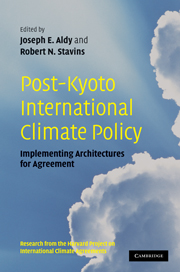Book contents
- Frontmatter
- Contents
- Harvard Environmental Economics Program, International Advisory Board
- Harvard Project on International Climate Agreements, Faculty Steering Committee
- Harvard Project on International Climate Agreements, Project Management
- List of figures
- List of tables
- List of contributors
- Foreword
- 1 Introduction
- Part I Alternative international policy architectures
- Part II Negotiation, assessment, and compliance
- Part III The role and means of technology transfer
- Part IV Global climate policy and international trade
- Part V Economic development, adaptation, and deforestation
- Part VI Modeling impacts of alternative allocations of responsibility
- 23 Modeling economic impacts of alternative international climate policy architectures: a quantitative and comparative assessment of architectures for agreement
- 24 Sharing the burden of GHG reductions
- 25 When technology and climate policy meet: energy technology in an international policy context
- 26 Revised emissions growth projections for China: why post-Kyoto climate policy must look east
- 27 Expecting the unexpected: macroeconomic volatility and climate policy
- Part VII Synthesis and conclusion
- Appendix A Selected List of Individuals Consulted, Harvard Project on International Climate Agreements
- Appendix B Workshops and Conferences, Harvard Project on International Climate Agreements
- Glossary and Abbreviations
- Index
26 - Revised emissions growth projections for China: why post-Kyoto climate policy must look east
Published online by Cambridge University Press: 05 June 2012
- Frontmatter
- Contents
- Harvard Environmental Economics Program, International Advisory Board
- Harvard Project on International Climate Agreements, Faculty Steering Committee
- Harvard Project on International Climate Agreements, Project Management
- List of figures
- List of tables
- List of contributors
- Foreword
- 1 Introduction
- Part I Alternative international policy architectures
- Part II Negotiation, assessment, and compliance
- Part III The role and means of technology transfer
- Part IV Global climate policy and international trade
- Part V Economic development, adaptation, and deforestation
- Part VI Modeling impacts of alternative allocations of responsibility
- 23 Modeling economic impacts of alternative international climate policy architectures: a quantitative and comparative assessment of architectures for agreement
- 24 Sharing the burden of GHG reductions
- 25 When technology and climate policy meet: energy technology in an international policy context
- 26 Revised emissions growth projections for China: why post-Kyoto climate policy must look east
- 27 Expecting the unexpected: macroeconomic volatility and climate policy
- Part VII Synthesis and conclusion
- Appendix A Selected List of Individuals Consulted, Harvard Project on International Climate Agreements
- Appendix B Workshops and Conferences, Harvard Project on International Climate Agreements
- Glossary and Abbreviations
- Index
Summary
Introduction
Growth rates in energy-related emissions of carbon dioxide (CO2) in developing countries, particularly the People's Republic of China, have increased rapidly in recent years. Emissions from the original signatories to the Kyoto Protocol (known as “Annex B countries”)— essentially the developed world and economies in transition—will almost certainly be surpassed by emissions from non-Annex B countries before 2010. Previous analyses projected that this crossing point would occur in 2020 or later (Weyant et al. 1999). The main source of unexpected emissions growth is China. According to the historical record provided by Marland et al. (2008), since 2000 the average annual growth rate in China's emissions has exceeded 10 percent, compared to 2.8 percent in the 1990s. Globally, the average growth rate since 2000 has been 3.3 percent, compared to 1.1 percent in the 1990s.
Raupach et al. (2007) decompose emissions growth in several regions into the factors of the Kaya identity: population, per capita income, energy intensity of gross domestic product (GDP), and carbon intensity of energy. In China, the first and last factors have been stable: population growth is slow and carbon intensity has remained consistently high due to heavy reliance on coal. Emissions growth has been driven by a combination of rapid economic development and the reversal of the past trend of declining energy intensity. Between 1980 and 2000, energy intensity in China had been falling faster than in any other major economy. This decline has been attributed to efficiency improvements at the firm level as market reforms privatized formerly state-operated enterprises (Fisher-Vanden et al. 2004).
- Type
- Chapter
- Information
- Post-Kyoto International Climate PolicyImplementing Architectures for Agreement, pp. 822 - 856Publisher: Cambridge University PressPrint publication year: 2009
- 12
- Cited by

